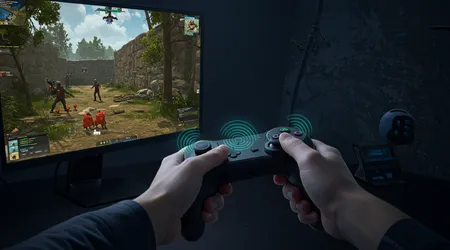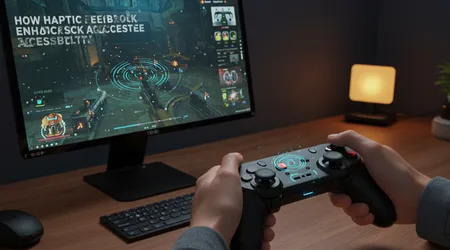How Haptic Feedback Enhances Accessibility in Gaming

Haptic feedback transforms gaming by bridging sensory gaps, making virtual worlds tangible for players with disabilities.
Imagine a racing game where you feel the gravel crunch beneath virtual tires or a shooter where vibrations signal enemy footsteps.
This tactile technology, rooted in vibrations, forces, and motions, creates immersive experiences that go beyond sight and sound.
For gamers with visual, auditory, or motor impairments, haptic feedback is a game-changer, fostering inclusion and redefining how we interact with digital environments.
In 2025, advancements in haptic feedback are reshaping accessibility, empowering diverse players to engage fully in gaming’s vibrant worlds.
Why does accessibility matter in gaming? It’s a question that resonates as the industry grows, with over 3 billion gamers worldwide in 2024, according to Statista.
Many face barriers due to disabilities, yet technology like haptic feedback is dismantling these obstacles. From controllers to wearable suits, this innovation delivers tactile cues that enhance gameplay for everyone.
This article explores how haptic feedback revolutionizes accessibility, diving into its mechanics, real-world applications, and future potential, with practical examples and insights grounded in current trends.
The Mechanics of Haptic Feedback in Gaming
Haptic feedback uses vibrations and forces to simulate touch. Devices like controllers or vests translate in-game actions into physical sensations, enhancing immersion.
For instance, Sony’s PlayStation 5 DualSense controller employs voice coil actuators for nuanced vibrations, mimicking textures like sand or rain.
This precision helps visually impaired players navigate virtual spaces by feeling environmental cues, making games more intuitive.
The technology varies from simple rumble motors to advanced piezoelectric actuators.
These create sensations like a bowstring’s tension or a weapon’s recoil. For deaf gamers, haptic feedback conveys audio cues, like explosions, through vibrations.
A 2023 study from Wichita State University found that 95% of players kept subtitles on in Assassin’s Creed: Odyssey, showing how multimodal feedback, including haptics, boosts accessibility.
Wearable devices, such as bHaptics’ TactSuit, expand this further. They deliver multi-point feedback across the body, simulating impacts or directional cues.
++ How Brain-Computer Interfaces Empower People with Paralysis
This allows motor-impaired players to feel game events without relying solely on visual or auditory input. The result is a richer, more inclusive gaming experience that adapts to diverse needs.
Haptic systems also integrate with VR platforms like Meta Quest, enhancing spatial awareness. Gloves with microfluidic actuators, like those from HaptX, let users “touch” virtual objects.
This tactile precision aids players with visual impairments in exploring game worlds, making interactions more natural and engaging.
The evolution of actuators, from bulky motors to slim piezoelectric designs, has made haptics more portable and precise.
These advancements ensure haptic feedback is seamless, reducing latency and enhancing responsiveness. For accessibility, this means faster, more reliable cues that empower players to react in real-time, leveling the playing field.

Real-World Applications for Accessibility
In practice, haptic feedback opens doors for gamers with disabilities. Consider The Last of Us Part I on PS5, where vibrations translate visual cues into tactile sensations.
A visually impaired player can feel enemy movements through distinct vibration patterns, improving navigation and combat.
This approach makes complex games accessible without altering core mechanics.
Wearable haptic devices, like the Subpac vest, are transformative for deaf gamers. By converting low-frequency audio into vibrations, Subpac lets players feel music or explosions.
For example, in Call of Duty: Warzone, a deaf player might sense enemy gunfire directionally, enhancing situational awareness and competitive play.
Also read: Open Source Assistive Devices You Can Build at Home
Motor-impaired gamers benefit from customizable haptic controllers. The Xbox Adaptive Controller, paired with haptic accessories, allows players with limited mobility to map inputs to tactile feedback.
In Forza Horizon 5, vibrations simulate road textures, helping players gauge speed and terrain without precise motor control.
Sony’s Access Controller, launched in 2023, integrates haptics for tailored feedback. A player with arthritis might use it to feel button presses with less physical strain.
This customization ensures gaming is inclusive, adapting to individual physical needs while maintaining immersion.
Haptic gloves, like those from HaptX, are gaining traction in VR. In Half-Life: Alyx, players with visual impairments can manipulate objects through tactile cues, feeling resistance or texture.
This bridges sensory gaps, making VR gaming accessible to a wider audience in 2025’s immersive landscape.
Challenges and Opportunities in Haptic Accessibility
Despite its promise, haptic feedback faces hurdles. Cost remains a barrier high-end devices like Teslasuit’s full-body haptic suit are expensive, limiting access.
Compatibility issues also persist, as not all games support advanced haptic systems, frustrating players who rely on them for accessibility.
Standardization is another challenge. Without unified protocols, haptic devices vary in functionality across platforms.
Industry alliances, like those noted in a 2025 MotoPaddock report, are pushing for interoperable standards. This could streamline development, ensuring more games integrate haptics seamlessly for accessibility.
Read more: Inclusive Design: Tech Products That Get It Right
Power consumption is a concern, especially for wearables. Haptic actuators drain batteries quickly, which can disrupt gameplay.
Advances in low-power piezoelectric technology, as seen in TDK Corporation’s innovations, are addressing this, promising longer sessions for disabled gamers.
Yet, opportunities abound. Haptic feedback can enhance educational gaming for children with disabilities.
In Minecraft Education, tactile cues could guide visually impaired students through virtual builds, fostering learning through touch. This expands gaming’s role beyond entertainment, promoting inclusion in education.
AI-driven haptics offer exciting prospects. By dynamically adjusting feedback based on real-time game physics, AI could personalize tactile cues for each player’s needs.
Imagine a system that adapts vibrations for a deaf player’s preferred intensity, making Apex Legends more immersive and accessible.

The Future of Haptic Feedback in Inclusive Gaming
Looking ahead, haptic feedback will redefine gaming inclusivity. Mid-air haptics, pioneered by Ultraleap, use ultrasonic waves to simulate touch without physical contact.
This could allow visually impaired players to “feel” virtual objects in AR games, expanding accessibility in 2025 and beyond.
Full-body haptic suits are evolving rapidly. Teslasuit’s 2025 pilots with educational institutions show how suits can aid visually impaired learners.
In gaming, these suits could simulate complex sensations, like wind or impacts, making God of War more immersive for disabled players.
| Device | Accessibility Feature | Example Game |
|---|---|---|
| PS5 DualSense Controller | Adaptive triggers, nuanced vibrations | The Last of Us Part I |
| Subpac Vest | Audio-to-tactile conversion for deaf players | Call of Duty: Warzone |
| Xbox Adaptive Controller | Customizable haptic mapping for motor impairments | Forza Horizon 5 |
| HaptX Gloves | Precise tactile feedback for VR | Half-Life: Alyx |
Cross-sensory integration is another frontier. Combining haptics with audio and visual cues creates multisensory experiences.
For deafblind players, a game like The Vale: Shadow of the Crown could use vibrations to convey narrative cues, enhancing storytelling accessibility.
Imagine gaming as a tapestry, where haptic feedback weaves touch into the fabric of sight and sound. This synergy could make every game a universal experience.
Developers are already experimenting with haptic APIs, as seen in bHaptics’ open SDK, enabling tailored feedback for diverse disabilities.
Engaging the Community and Industry
The gaming community drives haptic innovation. Social media platforms like X highlight player demand for accessibility, with posts praising Sony’s Access Controller for its tactile precision.
Developers must listen, integrating haptics into game design to meet these needs.
Industry collaboration is key. Partnerships between Sony, bHaptics, and accessibility advocates ensure haptic solutions align with player expectations.
Pilot programs, like Teslasuit’s 2025 educational trials, show how community feedback refines technology for broader adoption.
Gamers with disabilities are vocal about their needs. For example, a visually impaired player, Sarah, uses the DualSense controller to feel terrain changes in Horizon Forbidden West, enhancing her exploration.
Meanwhile, a deaf gamer, Alex, relies on Subpac to sense enemy movements in Fortnite, leveling his competitive edge.
What if every game prioritized haptic accessibility? This question challenges developers to innovate.
By 2030, the haptic technology market is projected to reach USD 13.74 billion, per a 2025 Forward Pathway report, driven by demand for inclusive gaming solutions.
Crowdsourcing haptic design ideas could accelerate progress. Platforms like Reddit host discussions where players suggest tactile cues for specific genres.
Incorporating these ideas ensures haptics evolve with the community, making gaming truly universal.
Conclusion
Haptic feedback is more than a buzzword it’s a lifeline for gamers with disabilities. From controllers to full-body suits, it transforms virtual worlds into tangible experiences.
By conveying audio, visual, and spatial cues through touch, haptics empower visually impaired, deaf, and motor-impaired players to engage fully.
Innovations like Sony’s Access Controller and HaptX gloves showcase real-world impact, while future advancements promise even greater inclusivity.
The journey isn’t without challenges cost, compatibility, and power consumption persist but the opportunities are vast.
As AI, mid-air haptics, and industry collaboration evolve, gaming will become a space where everyone belongs. Let’s champion this tactile revolution, ensuring every player feels the pulse of their favorite games.
Frequently Asked Questions
How does haptic feedback improve accessibility for visually impaired gamers?
It translates visual cues into tactile sensations, like vibrations for enemy movements, helping players navigate games like The Last of Us Part I.
What devices offer haptic feedback for gaming in 2025?
Devices include the PS5 DualSense, Xbox Adaptive Controller, Subpac vest, and HaptX gloves, each tailored for specific accessibility needs.
Are haptic devices affordable for most gamers?
High-end devices like haptic suits can be costly, but controllers like DualSense are more accessible, with prices starting around $70.
Can haptic feedback help deaf gamers?
Yes, devices like Subpac convert audio into vibrations, allowing deaf players to feel game sounds, enhancing immersion in titles like Call of Duty.
What’s the future of haptic feedback in gaming?
Advancements like mid-air haptics and AI-driven feedback will create more immersive, personalized experiences, especially for players with disabilities by 2030.
